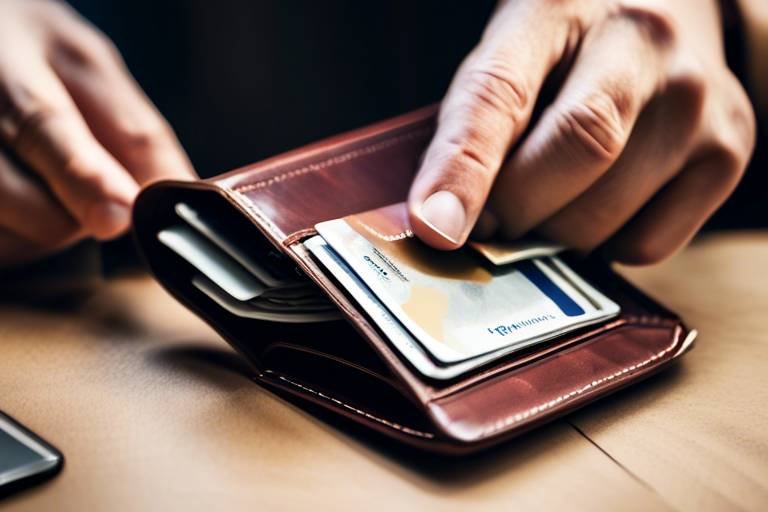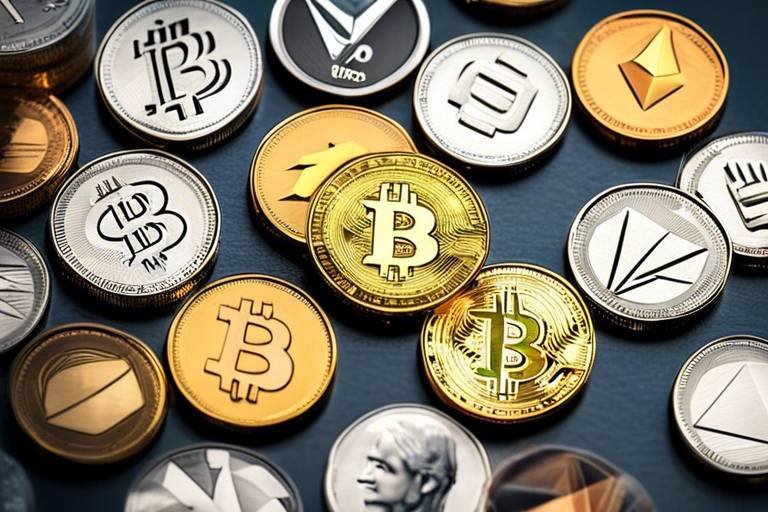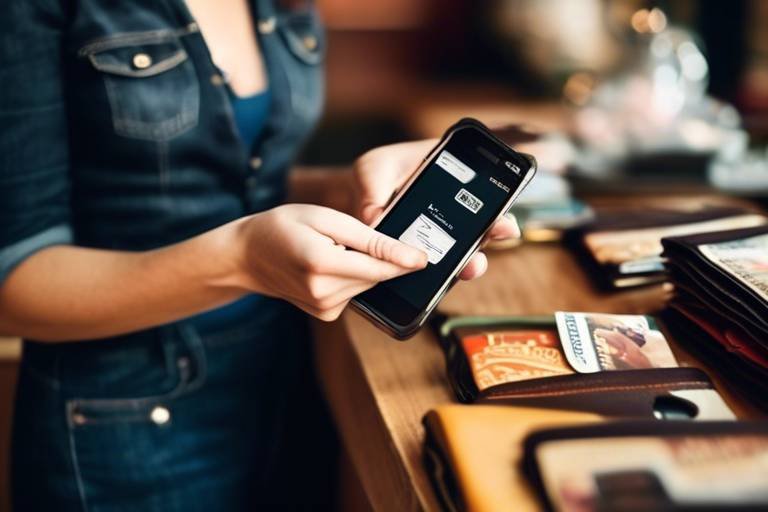The Future of Wallets in the Metaverse
Exploring the evolution of digital wallets in the metaverse, this article discusses their functionalities, security, and integration with virtual economies, along with the implications for users and businesses alike. The metaverse is not just a buzzword; it's a burgeoning digital universe where interactions, transactions, and experiences are taking on new dimensions. As we delve into this virtual realm, the role of digital wallets is becoming increasingly pivotal. Imagine a world where your wallet isn’t just a place to store cash or cards, but a gateway to a universe filled with endless possibilities. From purchasing virtual real estate to trading digital art, the future of wallets in the metaverse is not only exciting but also essential for navigating this new landscape.
Digital wallets are becoming increasingly popular as they offer convenience and security. But what’s driving this surge in adoption? For starters, the sheer convenience of having all your payment methods in one place is a game changer. No more fumbling through your purse or wallet to find the right card; with digital wallets, everything is just a tap away. Furthermore, as we embrace a more cashless society, digital wallets provide a secure way to make transactions without the risk of losing physical money. They are particularly appealing to younger generations, who are more tech-savvy and comfortable with digital transactions. In fact, studies show that the use of digital wallets is expected to grow exponentially in the coming years. The integration of features like loyalty programs, instant transfers, and even cryptocurrency support only adds to their allure.
As wallets move into the metaverse, security becomes paramount. With great power comes great responsibility, and the same goes for digital wallets. As users start storing more valuable assets in their wallets, the threat landscape also evolves. Cybersecurity threats such as hacking, phishing, and identity theft are real concerns that can undermine user confidence. To combat these challenges, developers are implementing advanced security measures, such as biometric authentication, multi-factor authentication, and end-to-end encryption. In a world where your virtual assets can be just as valuable as your real-world possessions, ensuring the safety of these wallets is crucial.
Cryptocurrencies are a key component of the metaverse economy. As digital wallets adapt to support various cryptocurrencies, they are also becoming essential tools for transactions in this new environment. Imagine being able to buy virtual goods with Bitcoin or Ethereum seamlessly. This integration not only simplifies transactions but also opens up a world of possibilities for users. However, with this flexibility comes responsibility. Users must be aware of the volatility of cryptocurrencies and the potential risks involved in their use. With the right digital wallet, users can navigate these waters more confidently, ensuring that their assets remain secure while they explore the metaverse.
The regulatory landscape surrounding cryptocurrencies is complex. As digital wallets evolve, so too does the need for compliance with existing regulations. Users should be aware of the laws governing cryptocurrency transactions in their jurisdictions. This includes understanding tax implications, reporting requirements, and the potential for legal changes that could affect how digital wallets operate. Staying informed is key, as regulations can change rapidly, impacting how users engage with their digital wallets in the metaverse.
Privacy is a significant concern for users in the metaverse. As our lives become increasingly intertwined with digital platforms, safeguarding personal information is more crucial than ever. Digital wallets are addressing these issues by implementing robust privacy measures, such as data encryption and anonymous transactions. Users can take control of their data, ensuring that their financial activities remain private. The evolution of privacy-focused digital wallets not only enhances user trust but also fosters a healthier ecosystem within the metaverse.
A user-friendly experience is essential for widespread adoption. As digital wallets become more sophisticated, the designs are evolving to enhance accessibility for all users in the metaverse. This means intuitive interfaces, seamless navigation, and support for various devices. Whether you’re a seasoned crypto trader or a newcomer to the digital world, a wallet that caters to your needs can make all the difference. By prioritizing user experience, wallet developers are paving the way for a more inclusive metaverse, where everyone can participate.
As the metaverse grows, so do the payment methods available. From traditional credit cards to cryptocurrencies, the options are expanding. Digital wallets are at the forefront of this evolution, adapting to accommodate emerging trends in payment systems. For instance, the rise of contactless payments and mobile transactions has fueled the demand for wallets that can handle these methods effortlessly. As we look to the future, it’s clear that digital wallets will play a pivotal role in shaping how we conduct transactions in the metaverse.
Non-fungible tokens (NFTs) are reshaping digital ownership. Digital wallets are facilitating NFT transactions, allowing creators and collectors to engage in this revolutionary market. Imagine being able to buy, sell, or trade unique digital assets with just a few clicks. Wallets designed for NFT transactions not only streamline the process but also provide security features that protect these valuable assets. As the NFT market continues to grow, the role of digital wallets will become even more significant.
Interoperability is crucial for a seamless experience. As users navigate different platforms within the metaverse, digital wallets are ensuring compatibility across various ecosystems. This means that your digital wallet can work seamlessly whether you’re in a gaming environment, a social platform, or a virtual marketplace. By prioritizing cross-platform compatibility, wallet developers are enhancing user experience, making it easier for individuals to manage their assets without the hassle of switching between different wallets.
- What is a digital wallet? A digital wallet is an electronic device or online service that allows individuals to make electronic transactions. It can store payment information and passwords for numerous payment methods and websites.
- How secure are digital wallets in the metaverse? Digital wallets in the metaverse are equipped with advanced security features such as encryption and multi-factor authentication to protect users' assets.
- Can I use my digital wallet for cryptocurrencies? Yes, many digital wallets support various cryptocurrencies, allowing users to conduct transactions using digital currencies.
- What are NFTs, and how do digital wallets facilitate their transactions? NFTs, or non-fungible tokens, are unique digital assets. Digital wallets facilitate NFT transactions by providing a secure platform for buying, selling, and trading these assets.

The Rise of Digital Wallets
In today's fast-paced digital age, digital wallets are emerging as the go-to solution for both consumers and businesses. Imagine walking into a store, and instead of fumbling through your pockets for cash or cards, you simply pull out your smartphone and make a purchase with a tap. This convenience is not just a fleeting trend; it's a revolution in how we handle money. The rise of digital wallets can be attributed to several key factors that are reshaping our financial landscape.
First and foremost, the demand for convenience is skyrocketing. In a world where time is of the essence, consumers are constantly seeking faster, easier ways to complete transactions. Digital wallets provide a seamless experience, allowing users to store multiple payment methods in one place. Whether it's credit cards, debit cards, or even loyalty points, everything is easily accessible at the touch of a button. This level of accessibility is a game changer, especially for those who are always on the go.
Another driving force behind the adoption of digital wallets is the increasing emphasis on security. Traditional payment methods are often fraught with risks, such as theft and fraud. Digital wallets utilize advanced encryption technologies and biometric authentication, such as fingerprint or facial recognition, to safeguard users' financial information. This added layer of security is reassuring for consumers, making them more inclined to embrace digital wallets as a safe alternative.
Moreover, the integration of digital wallets into various platforms is enhancing their appeal. From e-commerce websites to social media platforms, digital wallets are becoming an integral part of how we shop online. For instance, platforms like PayPal and Venmo have made it easier than ever to send money to friends or make purchases with just a few clicks. As more businesses adopt these payment methods, the convenience factor grows, further fueling the rise of digital wallets.
Additionally, the global shift towards contactless payments has played a significant role in the rise of digital wallets. The COVID-19 pandemic accelerated this trend, as consumers sought safer ways to shop without handling cash or physical cards. According to recent studies, the use of contactless payments surged by over 50% during the pandemic, with many users discovering the benefits of digital wallets for the first time.
As we look to the future, it's essential to recognize that the rise of digital wallets is not just a technological advancement; it's a cultural shift. More people are becoming comfortable with managing their finances digitally, and as this trend continues, we can expect to see even more innovations in the digital wallet space. For businesses, this means adapting to new consumer behaviors and integrating digital wallet options to stay competitive.
In conclusion, the rise of digital wallets is a multifaceted phenomenon driven by convenience, security, and the evolution of payment methods. As we continue to navigate this digital landscape, the implications for both users and businesses are profound. With the metaverse on the horizon, digital wallets will undoubtedly play a crucial role in shaping our financial interactions in virtual environments.
- What is a digital wallet? A digital wallet is an electronic device or online service that allows individuals to make electronic transactions, store payment information, and manage their finances.
- Are digital wallets safe? Yes, most digital wallets use advanced encryption and security measures such as biometric authentication to protect users' financial information.
- Can I use a digital wallet for cryptocurrency? Many digital wallets now support cryptocurrency transactions, allowing users to buy, sell, and store various types of digital currencies.
- How do I choose the right digital wallet? When selecting a digital wallet, consider factors such as security features, compatibility with your devices, and the payment methods it supports.

The advent of the metaverse has opened up a plethora of opportunities, but with these opportunities come significant security challenges that cannot be ignored. As we transition into this digital frontier, the question arises: how do we protect our assets in a realm that is both exciting and fraught with potential risks? The metaverse is not just a virtual playground; it is a complex ecosystem where personal data, digital assets, and cryptocurrencies intersect, making security a top priority for users and businesses alike.
One of the primary concerns is the threat of hacking. Just as in the physical world, where thieves target vulnerable homes, hackers are constantly on the lookout for weaknesses in digital wallets. These malicious actors can exploit vulnerabilities to gain unauthorized access to users' accounts, leading to significant financial losses. A recent survey indicated that over 60% of users are worried about the security of their digital assets in the metaverse, which highlights the urgency of addressing these challenges.
To combat these threats, developers are implementing a range of security measures designed to protect users. For instance, multi-factor authentication (MFA) is becoming a standard feature, requiring users to verify their identity through multiple means before accessing their wallets. This extra layer of security makes it considerably more difficult for hackers to succeed in their attempts. Additionally, the use of blockchain technology offers inherent security features, such as transparency and immutability, which can significantly reduce the risk of fraud.
Moreover, as digital wallets evolve, they are increasingly incorporating advanced technologies like artificial intelligence (AI) to detect suspicious activities in real-time. These AI-driven systems can analyze transaction patterns and flag any anomalies, providing users with timely alerts and potentially preventing unauthorized transactions before they occur. However, while these measures enhance security, they also raise questions about user privacy. How much data are users willing to share in exchange for enhanced protection?
Another critical aspect of security in the metaverse is the protection of personal data. As users engage in various activities—from shopping to socializing—their data is constantly being generated and collected. This data can be a goldmine for cybercriminals if not adequately secured. Companies must prioritize data encryption and ensure that robust privacy policies are in place to safeguard users' personal information. Users should also be proactive in understanding the privacy settings of the wallets they use and take measures to protect their data.
In summary, while the metaverse presents exciting possibilities for digital wallets, it also introduces a host of security challenges that require attention. Users must remain vigilant and informed about the potential risks and the protective measures available to them. As technology continues to advance, the landscape of security will evolve, but the fundamental principle remains: protecting users' assets and personal information is paramount.
- What are the most common security threats in the metaverse?
The most common threats include hacking, phishing attacks, and data breaches. Users should be aware of these risks and take necessary precautions. - How can I secure my digital wallet?
Utilize multi-factor authentication, ensure your wallet is updated, and be cautious about sharing personal information. - Are digital wallets in the metaverse safe?
While there are risks, many wallets implement advanced security measures such as encryption and AI monitoring to enhance safety. - What should I do if I suspect my wallet has been compromised?
Immediately change your passwords, enable additional security features, and contact customer support for your wallet service.

In the rapidly evolving landscape of the metaverse, cryptocurrency integration is not just a trend; it's a fundamental shift in how we perceive and conduct transactions. As digital wallets become the backbone of virtual economies, they are increasingly designed to support a variety of cryptocurrencies. This integration is crucial because it allows users to engage in seamless transactions, whether they're buying virtual real estate, trading digital art, or simply purchasing in-game items. Imagine walking into a virtual marketplace where you can pay for your digital goods with Bitcoin, Ethereum, or even lesser-known altcoins—all facilitated by your digital wallet!
The implications of this integration are profound. For one, it democratizes access to financial resources in the metaverse. Users from different backgrounds can engage in economic activities without the barriers often associated with traditional banking systems. Moreover, the ability to transact in cryptocurrencies enhances the fluidity of virtual economies. Just as you might swap cash for goods in a physical store, users can now easily exchange their cryptocurrencies for virtual assets, creating a vibrant marketplace that operates 24/7.
However, this integration is not without its challenges. Digital wallets must continuously adapt to accommodate the ever-changing landscape of cryptocurrencies. With thousands of cryptocurrencies available, each with its own unique features and use cases, wallets need to ensure that they can support a wide range of tokens. This requires robust backend systems and user-friendly interfaces that make it easy for users to manage their diverse portfolios. For instance, a wallet might offer features like:
- Multi-Currency Support: The ability to hold and transact with various cryptocurrencies.
- Real-Time Conversion Rates: Instant updates on cryptocurrency values to facilitate informed transactions.
- Transaction History Tracking: Easy access to past transactions for better financial management.
As we look ahead, the future of cryptocurrency integration in digital wallets will likely involve even more innovative features. Imagine a wallet that not only stores your cryptocurrencies but also provides insights into market trends, helping you make informed investment decisions. Or consider wallets that incorporate smart contracts to automate transactions, reducing the need for intermediaries and streamlining processes.
In conclusion, the integration of cryptocurrencies into digital wallets is a game-changer for the metaverse. It opens up new avenues for users and businesses alike, enabling a more inclusive and dynamic economic environment. As technology continues to advance, we can expect digital wallets to evolve further, making cryptocurrency transactions as easy as sending a text message.
Q: What cryptocurrencies can I use with digital wallets in the metaverse?
A: Most digital wallets support popular cryptocurrencies like Bitcoin and Ethereum, but many are expanding to include a variety of altcoins. It's essential to check the specific wallet for its supported currencies.
Q: Are digital wallets secure for cryptocurrency transactions?
A: While digital wallets offer security features such as encryption and two-factor authentication, users should also take precautions, like using hardware wallets for large amounts and keeping their recovery phrases safe.
Q: Can I use my digital wallet for NFT transactions?
A: Absolutely! Many digital wallets are now designed to facilitate NFT transactions, allowing users to buy, sell, and trade non-fungible tokens easily.

The rapid evolution of digital wallets within the metaverse has brought forth a myriad of regulatory considerations that users and businesses must navigate. As these wallets become integral to the virtual economy, understanding the regulatory landscape is essential for ensuring compliance and safeguarding assets. One of the primary challenges is the dynamic nature of cryptocurrency regulations, which can vary significantly from one jurisdiction to another. For instance, while some countries embrace cryptocurrency as a legitimate form of payment, others impose strict restrictions or outright bans. This inconsistency can create confusion for users trying to understand their rights and responsibilities.
Moreover, regulatory bodies are increasingly focused on anti-money laundering (AML) and know your customer (KYC) requirements. Digital wallet providers may be mandated to implement stringent verification processes to prevent illicit activities. This means that users might have to share personal information, which can lead to concerns about privacy and data security. It’s a delicate balance; while regulations aim to protect consumers, they can also deter individuals from fully engaging in the metaverse due to privacy fears.
In addition, the rise of decentralized finance (DeFi) platforms complicates regulatory oversight. Traditional financial regulations may not easily apply to these innovative systems, leading to a regulatory gray area. As a result, users should stay informed about potential changes in regulations that could impact their digital wallet usage. For example, some jurisdictions are considering implementing taxation policies on cryptocurrency transactions, which could affect how users manage their digital assets.
To illustrate the current regulatory landscape, here’s a summary of key considerations:
| Aspect | Details |
|---|---|
| Jurisdictional Variability | Regulations can differ widely between countries, affecting how wallets operate. |
| KYC/AML Compliance | Wallet providers may require user verification to comply with anti-money laundering laws. |
| Tax Implications | Potential taxation on cryptocurrency transactions could influence user strategies. |
| Decentralization Challenges | DeFi platforms may fall outside traditional regulatory frameworks, creating uncertainty. |
In conclusion, as the metaverse continues to expand, users must remain vigilant and informed about the evolving regulatory landscape. By understanding the implications of these regulations, users can better protect their assets and make informed decisions about their digital wallets. The key takeaway is to stay updated on local laws and regulations, as they can significantly impact how one navigates the metaverse.
- What are digital wallets? Digital wallets are online platforms that allow users to store, send, and receive digital currencies and assets.
- How do regulations affect my digital wallet? Regulations can dictate how wallets operate, including compliance with KYC and AML laws, and may impose taxes on transactions.
- What should I do if I have privacy concerns? It's important to research wallet providers and choose those with strong privacy policies and security measures in place.
- Will regulations change in the future? Yes, as the metaverse and cryptocurrency markets evolve, regulations are likely to change, so staying informed is crucial.

In the rapidly evolving landscape of the metaverse, user privacy has emerged as a critical concern for both individuals and businesses. As digital wallets become the primary means of conducting transactions in these virtual environments, the potential for data breaches and unauthorized access to personal information looms larger than ever. Imagine walking through a digital marketplace, purchasing virtual goods, only to realize that your sensitive information is being exposed to malicious actors. It’s a scenario that no one wants to face, and yet, it’s a reality that many are beginning to grapple with.
One of the most pressing issues is the collection and storage of user data. Digital wallets often require personal information such as names, email addresses, and even biometric data for added security. This information, if not adequately protected, can lead to identity theft or fraud. To combat these risks, developers are implementing advanced encryption techniques and two-factor authentication (2FA) systems, which act as a fortress around users' data. However, even with these measures, the question remains: how much of our personal information are we willing to share in exchange for convenience?
Moreover, the integration of digital wallets with various platforms raises additional privacy concerns. When users engage in transactions across multiple virtual environments, their data can be shared and analyzed by different entities, often without their explicit consent. This lack of transparency can lead to a feeling of vulnerability, as users may not fully understand how their information is being used or who has access to it. As a result, it’s crucial for wallet providers to establish clear privacy policies and offer users the ability to control their data. Empowerment in this context means giving users the tools to manage their privacy settings effectively.
Additionally, the rise of blockchain technology, while offering a level of security through decentralization, also introduces a paradox. On one hand, transactions are pseudonymous, which can protect user identities; on the other hand, the transparency of blockchain can lead to unintended exposure of transaction histories. This duality poses a significant challenge for digital wallet developers who must find a balance between providing security and ensuring user privacy.
In response to these challenges, some wallet providers are exploring innovative solutions. For instance, zero-knowledge proofs allow users to prove their identity or the validity of a transaction without revealing any specific details about that transaction. This technology not only enhances privacy but also builds trust among users who are increasingly wary of sharing their personal information in the digital realm.
In conclusion, as digital wallets continue to integrate into the metaverse, the focus on user privacy will only intensify. It is essential for users to remain vigilant and informed about the potential risks and to choose wallet providers that prioritize their privacy. Ultimately, the future of digital wallets in the metaverse will depend on how effectively they can safeguard user data while providing the convenience and functionality that users demand.
- What is a digital wallet? A digital wallet is an electronic device or online service that allows individuals to make electronic transactions and store payment information securely.
- How do digital wallets ensure user privacy? Digital wallets implement various security measures such as encryption, two-factor authentication, and privacy policies that give users control over their data.
- What are zero-knowledge proofs? Zero-knowledge proofs are cryptographic methods that allow one party to prove to another that a statement is true without revealing any information beyond the validity of the statement.
- Why is privacy important in the metaverse? Privacy is crucial in the metaverse to protect users from data breaches, identity theft, and unauthorized access to personal information.

In the rapidly evolving world of the metaverse, user experience and accessibility are not just buzzwords; they are essential components that determine the success of digital wallets. Imagine stepping into a virtual world where every transaction feels as seamless as flipping a light switch. That’s the kind of experience users are craving, and wallet developers are stepping up to the plate. The goal is to create an environment where users of all technical backgrounds can navigate their wallets effortlessly, regardless of their familiarity with technology.
One of the key aspects of enhancing user experience is intuitive design. Wallets are now being designed with user-friendly interfaces that guide users through each step of the process. For instance, incorporating visual cues and simple language can make a world of difference. Instead of overwhelming users with technical jargon, developers are opting for clear, concise instructions that make the experience feel more personal and less daunting. This approach not only improves usability but also builds trust among users.
Accessibility is another critical factor. It’s not just about making wallets easy to use; it’s about ensuring that everyone, regardless of their abilities, can access these digital tools. Developers are increasingly adopting inclusive design principles that cater to individuals with disabilities. This can include features like voice commands for those who may have difficulty using touch interfaces or customizable text sizes for users with visual impairments. By prioritizing accessibility, wallet providers are opening doors to a wider audience, fostering a sense of community within the metaverse.
Moreover, the incorporation of multilingual support is becoming more prevalent. As the metaverse transcends borders, users from different linguistic backgrounds are entering this digital realm. By offering wallet interfaces in multiple languages, developers are not only enhancing user experience but also promoting inclusivity. This global approach can significantly expand the user base, allowing more people to engage with the metaverse economy.
As we look to the future, it’s clear that the evolution of digital wallets in the metaverse is closely tied to user experience and accessibility. The more these wallets can cater to the diverse needs of users, the more likely they are to gain widespread adoption. After all, a wallet that feels like a natural extension of oneself is more than just a tool; it becomes an integral part of one’s digital identity.
- What is the importance of user experience in digital wallets?
User experience is crucial as it determines how easily users can navigate and utilize their wallets, impacting overall satisfaction and trust. - How are digital wallets becoming more accessible?
Developers are implementing inclusive design principles, such as voice commands and customizable text sizes, to cater to users with disabilities. - Why is multilingual support important in the metaverse?
Multilingual support fosters inclusivity and allows users from different linguistic backgrounds to engage with digital wallets effectively.

As the metaverse continues to expand, the landscape of payment methods is undergoing a radical transformation. Gone are the days when cash and credit cards were the sole means of transaction. In this digital frontier, users are discovering a plethora of innovative payment options that cater to the unique demands of virtual economies. The evolution of these payment methods is not just a trend; it’s a necessity driven by the growing complexity of digital interactions. So, what are these emerging trends, and how are digital wallets adapting to accommodate them?
One of the most exciting developments in the metaverse is the rise of cryptocurrencies as a primary payment method. These digital currencies, which operate on decentralized blockchain technology, offer users a secure and efficient way to transact without the need for intermediaries. Imagine buying virtual real estate or digital art with a simple click, all while knowing your transaction is protected by cryptographic security. This level of convenience is reshaping how we think about money in both the physical and virtual realms.
Moreover, the integration of Non-Fungible Tokens (NFTs) into the payment ecosystem is another game-changer. NFTs have revolutionized the concept of ownership in the digital space, allowing users to buy, sell, and trade unique digital assets. Digital wallets are evolving to seamlessly facilitate these transactions, ensuring that creators and collectors can engage in the metaverse economy without friction. This is particularly important as the demand for digital art, virtual goods, and collectibles skyrockets.
But it’s not just about cryptocurrencies and NFTs. The metaverse is also witnessing a surge in alternative payment methods that cater to diverse user preferences. For instance, some platforms are incorporating traditional payment methods like credit cards and bank transfers alongside digital currencies. This hybrid approach allows users to choose their preferred method of payment, enhancing accessibility and fostering broader adoption.
To illustrate this evolution, let’s take a look at a simple comparison of payment methods in the metaverse:
| Payment Method | Advantages | Disadvantages |
|---|---|---|
| Cryptocurrencies | Secure, decentralized, low transaction fees | Volatility, learning curve for new users |
| Credit/Debit Cards | Familiarity, instant transactions | Higher fees, reliance on banks |
| Bank Transfers | High limits, secure | Slower processing times, less convenient |
| PayPal and Similar Services | Easy to use, buyer protection | Fees can be high, not always accepted |
As we can see, each payment method comes with its own pros and cons, and digital wallets are at the forefront of this evolution. They are not only adapting to support various payment options but also enhancing user experience by integrating features that simplify transactions. For instance, many wallets now offer one-click payment options, making it easier than ever to engage in the metaverse economy.
Additionally, the concept of subscription-based payments is gaining traction. As more users participate in virtual worlds and services, the ability to pay for memberships and subscriptions seamlessly through digital wallets is becoming a vital feature. This shift not only streamlines the payment process but also encourages users to explore more of what the metaverse has to offer.
In conclusion, the future of payment methods in the metaverse is bright and full of possibilities. Digital wallets are evolving to accommodate a variety of payment options, enhancing user experience, security, and accessibility. As we continue to navigate this virtual landscape, it’s crucial for users to stay informed about these changes and how they can leverage them for their benefit.
- What are the primary payment methods in the metaverse? The primary methods include cryptocurrencies, credit/debit cards, bank transfers, and digital wallets.
- How do digital wallets enhance security? Digital wallets utilize advanced encryption and blockchain technology to secure transactions and protect user data.
- Can I use traditional payment methods in the metaverse? Yes, many platforms are integrating traditional payment methods alongside digital currencies for user convenience.
- What role do NFTs play in payments? NFTs allow for the buying and selling of unique digital assets, and digital wallets are evolving to facilitate these transactions.

In the ever-evolving landscape of the metaverse, non-fungible tokens (NFTs) have emerged as a revolutionary force, redefining the concept of digital ownership. Unlike traditional currencies or assets, NFTs are unique digital items that can represent anything from art and music to virtual real estate. As a result, the integration of NFTs into digital wallets is not just a trend; it’s a fundamental shift in how we perceive value and ownership in virtual spaces. Imagine holding a one-of-a-kind piece of art, not in your living room, but in a virtual gallery that you can visit anytime—this is the power of NFTs.
Digital wallets are adapting to facilitate these transactions, ensuring that users can easily buy, sell, and trade NFTs. Most wallets now offer features specifically designed for NFT management, allowing users to view their collections, track market trends, and execute transactions seamlessly. This is akin to having a personal art curator at your fingertips, guiding you through the digital art world with ease and efficiency. However, with this convenience comes a responsibility to understand how these transactions work and the implications they carry.
One of the exciting aspects of NFTs is their ability to create new revenue streams for artists and creators. By using digital wallets to sell their work directly to consumers, artists can bypass traditional gatekeepers and retain a larger share of the profits. Moreover, NFTs can include smart contracts that ensure artists receive a percentage of future sales, creating a sustainable income model. This is a game-changer, as it allows creators to earn from their work long after the initial sale, much like receiving royalties for a hit song.
However, as with any emerging technology, challenges exist. The market for NFTs can be volatile, with prices fluctuating wildly based on demand and trends. Digital wallets must therefore incorporate robust analytics and tracking features to help users make informed decisions. Imagine trying to sell a piece of art that was once worth thousands, only to find it’s now valued at a fraction of that amount. This uncertainty highlights the importance of understanding the market dynamics and utilizing your digital wallet wisely.
Moreover, the environmental impact of NFTs has sparked debates within the community. Many NFTs are minted on blockchains that require significant energy consumption, raising concerns about sustainability. As a response, some digital wallets are beginning to support eco-friendly platforms that utilize less energy-intensive methods for creating and trading NFTs. This shift not only addresses environmental concerns but also attracts a growing demographic of eco-conscious users who want their digital assets to reflect their values.
In conclusion, as NFTs continue to gain traction within the metaverse, digital wallets will play a crucial role in facilitating these transactions. They are not just tools for buying and selling; they are gateways to a new world of digital ownership and creativity. As users navigate this exciting landscape, it’s essential to remain informed about the evolving nature of NFTs and the functionalities of their digital wallets. With the right knowledge and tools, anyone can become a part of this digital revolution.
- What are NFTs? NFTs are unique digital tokens that represent ownership of a specific item, such as art, music, or virtual real estate, on a blockchain.
- How do digital wallets support NFT transactions? Digital wallets allow users to store, buy, sell, and trade NFTs, often including features for tracking market trends and managing collections.
- Are NFTs environmentally friendly? Many NFTs are minted on energy-intensive blockchains, but there are eco-friendly alternatives that some wallets are beginning to support.
- Can creators earn from their NFTs after the initial sale? Yes, through smart contracts, creators can receive a percentage of future sales, ensuring ongoing revenue from their work.

In the rapidly evolving metaverse, cross-platform compatibility has emerged as a crucial factor in ensuring a seamless user experience. Imagine trying to enjoy a concert in a virtual reality space, only to find out that your digital wallet doesn’t work with the platform hosting the event. Frustrating, right? This scenario highlights the importance of wallets being able to operate across various platforms, allowing users to transact effortlessly regardless of where they are in the metaverse.
Digital wallets are now designed with interoperability in mind, which means they can connect and function across different virtual environments. This is not just a convenience; it’s a necessity. As users jump from one virtual world to another, they expect their wallets to accompany them, just like a trusty backpack that holds all their essentials. The technology behind this compatibility is evolving, utilizing APIs and blockchain technology to create a unified experience for users.
Moreover, the metaverse encompasses a diverse range of platforms, each with its own unique features and currencies. For instance, a user might want to purchase virtual real estate in one platform while buying digital art in another. Here’s where cross-platform compatibility shines. By allowing users to manage their assets and make transactions across different platforms, digital wallets not only enhance user satisfaction but also encourage a more vibrant and interconnected metaverse economy.
| Platform | Wallet Compatibility | Supported Currencies |
|---|---|---|
| Decentraland | MetaMask, Coinbase Wallet | ETH, MANA |
| Cryptovoxels | MetaMask, Fortmatic | ETH, CVPA |
| Sandbox | MetaMask, WalletConnect | ETH, SAND |
As we look ahead, the future of digital wallets in the metaverse will likely see even greater advancements in cross-platform compatibility. This includes the potential for universal wallets that can seamlessly integrate with multiple platforms, allowing users to manage their digital assets in one place. Think of it as a universal remote for your digital life—one tool to control everything, making interactions within the metaverse as smooth as possible.
However, this evolution comes with its own set of challenges. Developers must ensure that security measures are robust enough to protect users' assets while maintaining ease of use across different platforms. As the metaverse grows, the demand for secure, compatible, and user-friendly wallets will only increase. Thus, it is essential for wallet providers to stay ahead of the curve, continuously innovating to meet the needs of an ever-expanding digital landscape.
- What is cross-platform compatibility? Cross-platform compatibility refers to the ability of digital wallets to function seamlessly across different virtual environments and platforms.
- Why is it important for digital wallets in the metaverse? It allows users to manage their assets and make transactions effortlessly across various platforms, enhancing user experience and promoting a more interconnected economy.
- How do digital wallets ensure security while being cross-platform compatible? By implementing advanced security protocols and encryption methods, wallet providers can protect users' assets while facilitating cross-platform transactions.
Frequently Asked Questions
-
What are digital wallets in the metaverse?
Digital wallets in the metaverse are virtual tools that allow users to store, manage, and transact various digital assets, including cryptocurrencies and non-fungible tokens (NFTs). They provide a convenient way to engage in the virtual economy, making transactions seamless and secure.
-
How do digital wallets enhance security in the metaverse?
Security is a top priority for digital wallets in the metaverse. They employ advanced encryption techniques, multi-factor authentication, and regular security audits to protect users' assets. Additionally, many wallets are integrating biometric security features to further safeguard personal information.
-
Can I use my digital wallet for cryptocurrency transactions?
Absolutely! Most digital wallets in the metaverse are designed to support a variety of cryptocurrencies. They allow users to easily buy, sell, and transfer digital currencies, making it easier to participate in the growing metaverse economy.
-
What are the regulatory considerations for using digital wallets?
The regulatory landscape for digital wallets can be complex and varies by region. Users should be aware of local laws regarding cryptocurrency transactions, taxation, and consumer protection to ensure compliance while using their wallets in the metaverse.
-
How do digital wallets protect user privacy?
Digital wallets prioritize user privacy by implementing robust data protection measures. They often use decentralized technologies to minimize the amount of personal information stored and give users control over their data, ensuring that transactions remain confidential.
-
What features make digital wallets user-friendly?
User-friendly features in digital wallets include intuitive interfaces, easy navigation, and customizable settings. Many wallets also offer tutorials and customer support to help users understand how to utilize all available functionalities effectively.
-
What payment methods are evolving in the metaverse?
The metaverse is witnessing a rise in various payment methods, including cryptocurrency payments, credit card integrations, and even direct bank transfers. Digital wallets are adapting to accommodate these changes, making it easier for users to transact in the virtual world.
-
How are digital wallets facilitating NFT transactions?
Digital wallets are crucial for NFT transactions as they allow users to buy, sell, and store NFTs securely. They provide a platform for creators and collectors to interact, ensuring that ownership and transaction history are easily verifiable on the blockchain.
-
What is cross-platform compatibility for digital wallets?
Cross-platform compatibility refers to the ability of digital wallets to function seamlessly across different metaverse platforms. This ensures that users can access their assets and make transactions without being restricted to a single environment, enhancing the overall user experience.



















